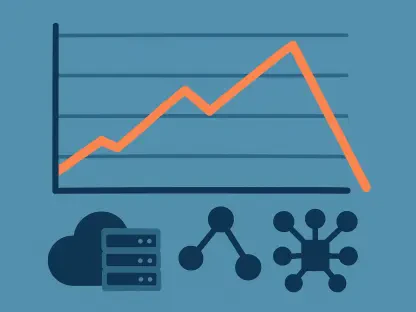Picture a future where businesses that cling to outdated methods are outpaced by competitors who have harnessed cutting-edge technology to streamline their operations, a scenario that experts predict will become a stark reality by 2026, fundamentally altering the competitive landscape. In this fast-approaching environment, business automation—leveraging technology to execute repetitive tasks without human intervention—will transform from a strategic option into a fundamental requirement for survival. Companies embracing automation stand to gain substantial benefits, including slashed operational costs, heightened efficiency, and the ability to meet ever-rising customer expectations for speed and precision. Those who hesitate, however, risk falling behind, burdened by the inefficiencies and high costs of manual processes. This shift is not mere speculation; it’s supported by compelling evidence showing automated businesses already operate with 22% lower expenses and deliver faster responses to market demands. By 2026, this divide will likely determine which organizations thrive and which struggle to stay afloat in an increasingly competitive environment.
The momentum toward automation is fueled by broader changes in how work is conducted and what stakeholders demand. With flexible and remote work arrangements becoming the norm—evidenced by 40% of job postings offering such options this year—automation emerges as the critical tool to maintain seamless operations across dispersed teams. Beyond workforce dynamics, the sheer waste of time on repetitive tasks, costing employees over 500 hours annually, underscores the urgent need for technology to reclaim that potential for innovation and growth. As the business world races toward 2026, the integration of artificial intelligence (AI) into automation promises to further widen the gap, offering adaptive solutions that redefine efficiency. The stakes are clear: automation is not just about keeping up; it’s about securing a lasting competitive edge.
The Urgency and Impact of Automation
Why 2026 Is the Tipping Point
By 2026, the business landscape is expected to reach a critical juncture where automation will separate the leaders from the laggards, driven by unrelenting market competition and the pressing need for speed in operations. This timeline isn’t arbitrary; it reflects the accelerating pace at which technology is reshaping industries, leaving little room for companies reliant on slow, manual methods. Data paints a striking picture: automated businesses currently enjoy a 22% reduction in operational costs compared to their non-automated counterparts, a gap that will only widen as efficiency becomes paramount. Moreover, the financial incentive is undeniable, with studies revealing a return of $5.44 for every dollar invested in automation, primarily due to faster response times and streamlined processes. This economic advantage positions automation as a make-or-break factor, particularly for organizations aiming to stay relevant in a market where customer expectations for rapid service continue to escalate. By 2026, failing to adopt these technologies could mean not just falling behind, but facing potential obsolescence as competitors capitalize on these gains.
The urgency of this shift is further amplified by the broader economic and technological trends shaping the business environment. As global investment in automation technologies surges—with the workflow automation market projected to reach $18.45 billion this year—organizations are increasingly recognizing that delays in adoption carry steep opportunity costs. Beyond finances, the pressure to meet heightened consumer demands for near-instantaneous service adds another layer of complexity. Businesses that automate now can pivot quickly, addressing market shifts with agility that manual processes simply cannot match. By 2026, this agility will likely become a defining trait of successful enterprises, while those stuck in outdated systems may struggle to retain customers, talent, and market share. The message is clear: the window to act is narrowing, and the consequences of inaction are growing more severe with each passing day.
Automation and the Modern Workforce
Automation stands as a linchpin in supporting the rapid evolution of work environments, particularly as remote and flexible arrangements become mainstream across industries. Recent data highlights that 40% of job postings now offer such options, a significant leap from just a couple of years ago, reflecting a profound shift in workforce expectations. For businesses managing decentralized teams, automation offers a vital solution to ensure continuity and efficiency, regardless of where employees are located. By replacing manual handoffs and paper-based systems with digital workflows, companies can maintain consistent operations whether staff are in-office, at home, or on the move. This capability is not just a convenience; it’s a necessity in a world where physical proximity no longer dictates productivity, and where delays caused by traditional methods can erode trust and performance among distributed teams.
Beyond bridging geographical gaps, automation addresses the deeper inefficiencies that plague modern workplaces with scattered personnel. Manual processes often create bottlenecks—think delayed approvals or mismatched data across systems—that slow down decision-making and frustrate employees. Automated tools eliminate these friction points by standardizing tasks and centralizing information, ensuring that critical updates or approvals happen in real time. This not only boosts operational speed but also enhances employee satisfaction by reducing the frustration of repetitive, low-value work. As flexible work models are expected to grow—with 65% of employees anticipating further increases in such setups—automation will be indispensable for maintaining cohesion and momentum. By 2026, businesses that fail to leverage these technologies risk alienating talent and losing ground in a workforce that increasingly values efficiency and adaptability.
Key Areas for Efficiency Gains
Reclaiming Lost Time
One of the most compelling arguments for business automation lies in its ability to rescue countless hours lost to repetitive, mundane tasks that burden employees every day. Research indicates that over half of workers spend upwards of 500 hours annually on activities like data entry, status updates, or manual error corrections—time that could be redirected toward strategic initiatives or innovation. This staggering figure translates to more than 20 hours per week per employee, representing a massive drain on organizational potential. Automation steps in as a powerful remedy, taking over these routine processes with precision and speed, thereby freeing staff to focus on higher-value contributions. Whether it’s automating expense reporting or streamlining customer notifications, the impact is immediate, allowing businesses to reallocate human capital to areas that drive growth and competitive differentiation.
The ripple effects of reclaiming this lost time extend far beyond individual productivity, reshaping entire organizational priorities. When employees are no longer bogged down by tedious workflows, they can engage in creative problem-solving, customer relationship building, or product development—activities that directly influence long-term success. Automation also reduces the mental fatigue associated with repetitive tasks, fostering a more motivated and engaged workforce. Specific pain points, such as correcting manual errors through automated data validation or speeding up information retrieval via centralized systems, highlight the breadth of efficiency gains possible. By 2026, companies that harness these time-saving benefits will likely see not only improved output but also a stronger ability to attract and retain talent who seek workplaces that prioritize meaningful work over rote labor.
Shipping Automation as a Game-Changer
Shipping automation emerges as a particularly impactful entry point for businesses looking to dip their toes into broader automation strategies, offering swift and tangible benefits across multiple departments. This area of focus is especially potent because shipping intersects with critical functions like order fulfillment, customer communications, and invoicing, making it a high-leverage opportunity for efficiency. Companies adopting automated shipping solutions often witness results within days, gaining access to better carrier rates, streamlining multi-carrier processes, and reducing manual errors in labeling or tracking. These immediate wins translate into cost savings and faster delivery times, directly enhancing customer satisfaction while cutting operational overhead. As a starting point, shipping automation proves that even targeted technological interventions can yield outsized returns, building momentum for more comprehensive automation efforts.
The broader implications of starting with shipping automation lie in its ability to catalyze a domino effect throughout an organization, inspiring adoption in other areas. Once teams experience the time savings and error reduction in shipping—often within the first week—they become more receptive to exploring tools for marketing, such as automated post-purchase campaigns, or human resources, like streamlined onboarding processes. This creates a culture of efficiency, where the initial success in one domain sparks curiosity and enthusiasm for optimizing others. Moreover, shipping automation’s cross-departmental reach ensures that benefits are felt widely, from warehouse staff to customer service teams, reinforcing the value of technology-driven solutions. By 2026, businesses that leverage shipping as a launchpad for automation will likely be better positioned to scale these practices, turning incremental gains into a holistic competitive advantage.
Future Trends and Competitive Edge
The Power of AI in Automation
As automation evolves, the integration of artificial intelligence (AI) is poised to elevate its impact to unprecedented levels, offering adaptive and learning-based systems that redefine operational efficiency by 2026. Unlike traditional automation, which operates on fixed rules, AI-powered tools analyze patterns, predict outcomes, and adjust to dynamic conditions in real time. For instance, in shipping, AI can optimize carrier selection based on historical data, or in inventory management, it can forecast demand spikes during peak seasons. This shift from static efficiency to intelligent responsiveness enables businesses to not only save time but also anticipate needs, reducing waste and enhancing precision. By 2026, organizations that adopt AI-driven automation will likely set a new benchmark for speed and accuracy, creating a significant gap over competitors still reliant on basic or manual processes.
The potential of AI extends beyond operational tweaks, promising a fundamental transformation in how businesses strategize and compete. With the ability to learn from vast datasets, AI can uncover inefficiencies that might go unnoticed by human oversight, such as subtle bottlenecks in workflows or underutilized resources. This predictive capability allows companies to stay ahead of disruptions, whether it’s a sudden surge in orders or supply chain delays, ensuring continuity and customer trust. Furthermore, AI’s adaptability means automation systems grow smarter over time, continuously refining their performance without constant human input. As investment in intelligent automation surges—with 80% of organizations increasing budgets this year—the adoption of AI will likely become a defining factor in market leadership. By 2026, failing to embrace this technology could mean not just lagging behind, but becoming entirely irrelevant in a hyper-competitive landscape.
Time as the Ultimate Advantage
Automation’s ability to save time translates directly into a formidable competitive edge, influencing relationships with customers, employees, and business partners alike. In an era where speed is paramount, customers gravitate toward vendors who deliver rapid responses and seamless experiences, often made possible by automated systems that cut down processing delays. Employees, too, value workplaces that minimize time wasted on repetitive tasks, allowing them to engage in meaningful, fulfilling work. Partners and collaborators similarly favor efficient counterparts who can keep pace with tight deadlines and streamlined interactions. By automating routine functions, businesses unlock hours that can be reinvested into strategic priorities—be it enhancing customer service, innovating new products, or expanding market reach—solidifying their position as industry frontrunners by 2026.
This focus on time as a differentiator also drives a profound cultural shift within organizations, embedding a mindset that prioritizes efficiency at every level. When automation frees up significant chunks of the workday—often over 20 hours weekly per employee—it fosters an environment where continuous improvement becomes the norm rather than the exception. Teams begin to seek out and champion additional automation opportunities, from workflow approvals to data management, creating a virtuous cycle of optimization. Current trends reinforce this trajectory, with 75% of businesses viewing automation as essential for maintaining a competitive stance, and global investments reflecting a collective push toward smarter, faster operations. By 2026, companies that have cultivated this time-centric culture through automation will not only outpace rivals mired in outdated habits but also build resilience against future market shifts, ensuring long-term sustainability and success.
Reflecting on Automation’s Lasting Legacy
Looking back, the journey toward widespread business automation revealed a transformative era where technology reshaped the very foundation of how companies operated. By 2026, those who had embraced automation carved out dominant positions in their markets, benefiting from reduced costs, accelerated responses, and the strategic redeployment of time toward innovation. The evidence was stark: automation delivered returns exceeding $5 for every dollar spent, while manual inefficiencies sapped up to 30% of revenue through delays and errors. Shipping automation proved a pivotal starting point, offering quick wins that spurred broader adoption, while AI’s integration marked a leap into intelligent, adaptive systems. Moving forward, the focus should shift to scaling these successes—identifying untapped areas for automation, investing in employee training to maximize tech adoption, and staying ahead of AI advancements. Businesses must also prioritize fostering a culture that views time as a precious asset, ensuring that every saved hour fuels growth. As the landscape continues to evolve, proactive adaptation to emerging tools and trends will remain crucial, solidifying automation as not just a tool for efficiency, but a cornerstone of enduring competitiveness and resilience.









